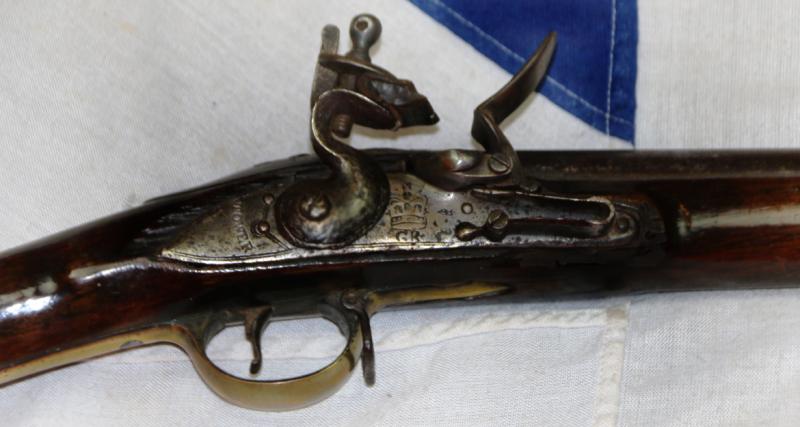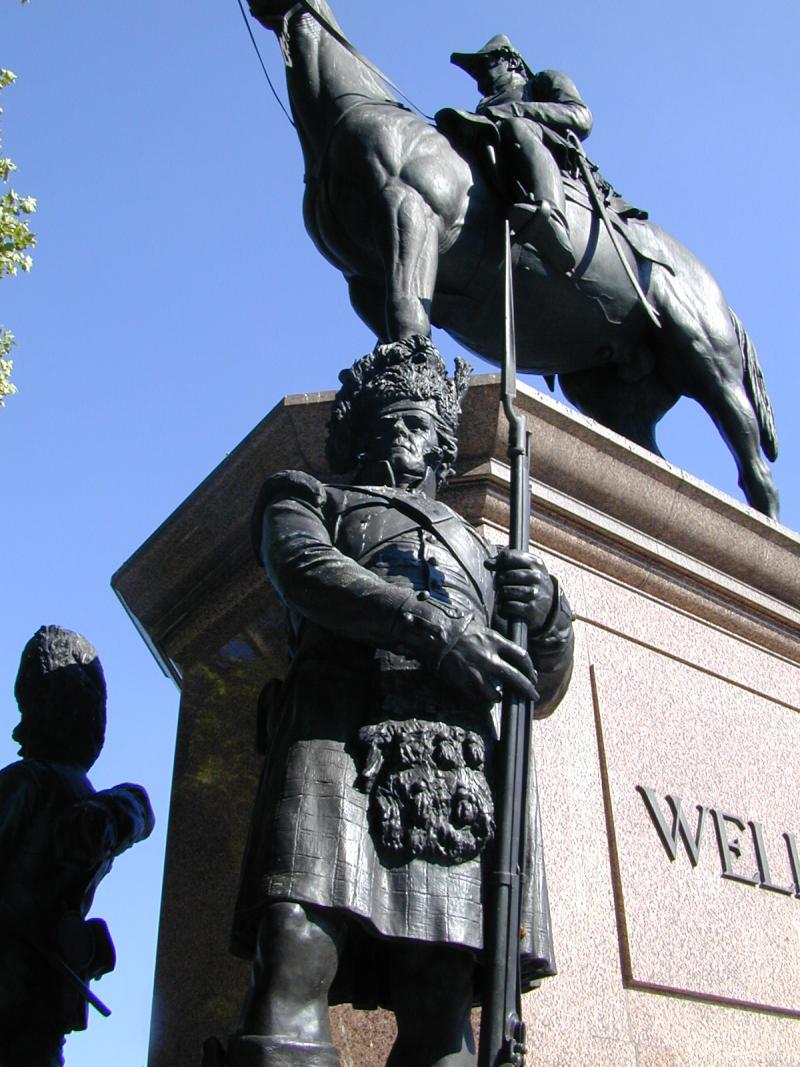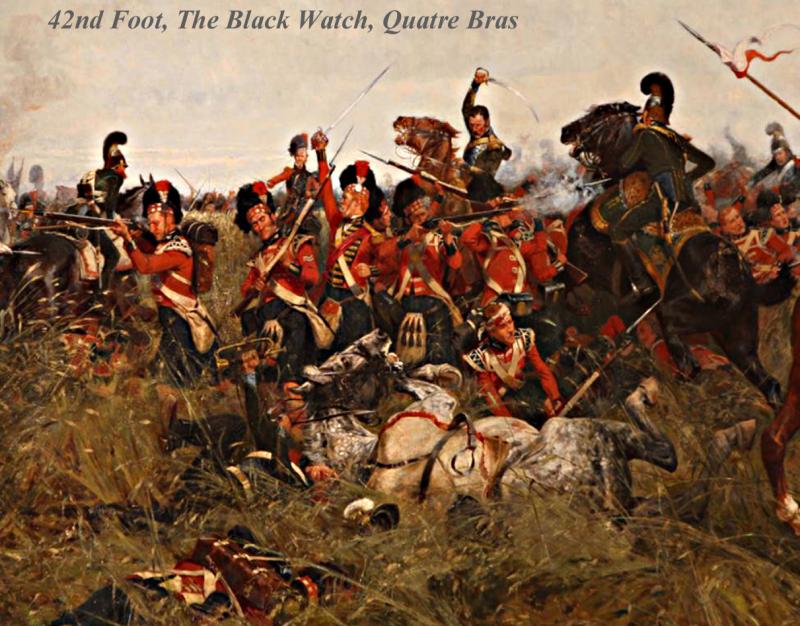A Beauty! Scottish Regt. Issue 'Tower Of London' GR Crown 'Brown Bess' Musket of the Napoleonic Wars, Peninsular War & Waterloo With Bayonet. Scottish Regimental Markings for Renfrewshire Regt. Then Transferred To The 42nd Foot the 'Black Watch'
Probably the only Scottish infantryman’s regulation issue regimentally marked Napoleonic Wars 'Brown Bess' available on the open market today, and certainly the first we have seen in over 20 years. Officers private purchase versions regimentally marked are unusual but they do appear No and again, but other ranks regulation issue regimental marked muskets are another thing entirely. Thus, it is such a rarity, that another may not appear again for decades. Made for the Renfrewshire Regiment as a defence against a feared French invasion of Scotland, then transferred after the Peace of Amiens treaty in 1802, to the Scottish line regiment, the Black Watch, for service use, including, from 1808 to 1814, in Portugal & Spain for the Peninsular Campaign, and later at Quatre Bras and Waterloo in 1815.
Renfrewshire, in Scotland, resolved to tender an offer to the Government in October 1794, to raise a corps of infantry consisting of 400 men for the defence of their part of Scotland in case of a French invasion. The offer was accepted, and on October 25 following, the men marched to the Cross of Paisley, gave four volleys in honour of the King, and were presented with a stand of colours by the Magistrates. On November 25, they were reviewed by Major-General Hamilton, the field being kept by the Renfrewshire Cavalry, who were themselves reviewed in the following August by the same officer. This musket was issued to the Renfrewshire Regiment and the barrel engraved by the regimental armourer for the Ist Renfrewshire, rack numbered gun, 106. The regiment were under the command of the Earl of Glasgow, their Colonel. In August 31, 1799, the whole of the men in the shire were reviewed at Barnsford by General Drummond. The number of officers and men put upon the field is given at over 1,500. The Regiment was disbanded in 1802 {in Glasgow} at the Peace of Amiens, and their arms transferred to a local Scottish line regiment, also in Glasgow, the 42nd Foot the 'Black Watch', which was in Glasgow at the time. The Treaty of Amiens, (March 27, 1802), was an agreement signed at Amiens, France, by Britain, France, Spain, and the Batavian Republic (the Netherlands), achieving a peace in Europe for 14 months during the Napoleonic Wars. After Waterloo the regiment spent many years based in Ireland, and 1842 this musket was left in Ireland, as the regiment were issued with the new percussion action 1842 muskets, prior to the regiment moving to Malta. At that point, the musket, now likely within an Irish volunteer militia, was stamped for the gun census in County Antrim {A.N} in August 1843
Probably the most famous military flintlock musket in the world today, and certainly one of the most historically important and desirable long guns of its type from the Napoleonic wars.
A typical regulation example, made and issued to a Scottish Regiment, in around 1797, and in very good and in very sound combat service condition, with a stunning natural patination colour. A very good British Napoleonic Wars regulation, regiment-of-the-line issue musket, Crown GR and made at the Tower of London, with swan neck cock lock with government GR Crown stamp, regulation brass mounts, iron ramrod, sling swivels and triangular socket bayonet {pitted}. Fabulous walnut stock with signs of Napoleonic Wars combat use, yet still exceptionally fine. A musket that it would be highly unlikely ever to improve upon historically, to find a better example.
On 8 March 1801, The 42nd took part in the Battle of Aboukir, a decisive victory by the British expeditionary force. At 9 am the troops beached their craft under a rainstorm of a French cannonade and musket fire from 2,500 French positioned on the high dunes. The troops disembarked, formed a line, fixed bayonets and advanced, undaunted by the enemy fire. With General Moore leading the landing force. The 42nd, located in the centre of the landing force, struggled up the steep soft sandy ground. The French appeared at the summit and poured a destructive musket volley at the advancing soldiers. The lead troops of the 42nd reached the summit before the French could reload and launched a bayonet charge, hurling them back in confusion. The French counter attacked with a squadron of cavalry, a second bayonet charge by the 42nd caused them to flee. The British losses were 102 all ranks killed and 515 wounded; of these the 42nd Highlanders had 31 killed. The commanding officer, Lt Colonel James Stewart, 6 officers, 7 sergeants, 4 Drummers, and 140 rank and file were wounded. James Stewart had been wounded along with a few soldiers as the boats came into shore. The leadership by the company commanders and subsequent success against an enemy of double the British numbers was noteworthy.
The Battle of Aboukir allowed a bridgehead to be created as a prelude to the Battle of Alexandria thirteen days later on the 21st March 1801. The 42nd was commanded by Lt Colonel Alexander Stewart after the wounding of Lt Col James Stewart at Aboukir. During the Battle Major Stirling captured a standard from the French which he handed to Sergeant Sinclair who was later wounded and subsequently the standard was lost.
They went on to besiege Cairo and then Alexandria in which the French forces were expelled from Egypt.
Peninsular War
The 1st battalion embarked for Portugal in August 1808 for service in the Peninsular War. At the Battle of Corunna in January 1809 it was a soldier of the 42nd Highlanders who carried the mortally wounded General Sir John Moore to cover, and six more who carried him to the rear, but only after he had witnessed the victory in which the stout defence of the Black Watch played a major part. Moore's army was evacuated from Spain and the 1st Battalion of the 42nd Highlanders went with them.
As the 1st battalion left, the 2nd battalion was dispatched from Ireland to Spain for their service in the Peninsular War. The 2nd battalion fought at the Battle of Bussaco in September 1810 before falling back to the Lines of Torres Vedras. The 2nd battalion fought with great distinction at the Battle of Fuentes de Oñoro in May 1811, the siege of Ciudad Rodrigo in January 1812 and the bloody siege of Badajoz in March 1812 before returning home to recruit. The 1st battalion returned to the Peninsula in time to fight in the Battle of Salamanca in July 1812, the siege of Burgos in September 1812 and the Battle of Vitoria in June 1813. It then pursued the French Army into France and fought at the Battle of the Pyrenees in July 1813, the Battle of Nivelle in November 1813 and the Battle of the Nive in December 1813 before seeing action at the Battle of Orthez in February 1814 and the Battle of Toulouse in April 1814
With the war with France now apparently over, the 2nd battalion was disbanded in 1814 and some of its number transferred to the permanent 1st battalion. The now single battalion 42nd fought at the chaotic Battle of Quatre Bras on 16 June 1815 under Lieutenant-colonel Sir Robert Macara, who was killed by French lancers. The 42nd was one of four battalions mentioned by Wellington in dispatches after the battle. Two days later at the Battle of Waterloo, the 42nd and also the 2nd/73rd Highlanders, which was later to become the new 2nd Battalion, Black Watch, were both in some of the most intense fighting in the battle
The Brown Bess musket began its life almost 300 years ago, and it helped in creating one of the greatest trading empires the world has ever seen and, among other achievements, made the 'British Square' the almost undefeated form of infantry defence throughout the world.
With the onset of the Napoleonic Wars in the 1790s, the British Board of Ordnance found itself woefully short of the 250,000 muskets it would need to equip its forces. It managed to produce around 20,000 short land pattern muskets but this was simply not sufficient. At that time the British East India Company maintained it own troops and had contracted with makers to produce a simplified version of the Brown Bess musket with a 39-inch barrel and less ornate furniture and stock work. It was generally felt that the standard of these "India pattern" muskets was not up to the standard of the earlier Besses, but necessity required action so the authorities convinced Company officials to turn over their stores to the Crown. By 1797 the urgencies of war ultimately created the demise of the Short Pattern, and all manufacture was turned to building the more simple 'India' pattern. For the most part, the gun underwent few changes from its introduction until Waterloo, with the exception of the cock, which was altered from the traditional swan-neck style to a sturdier, reinforced ringed version in around 1808. This musket has the earlier 18th century swan necked cock
Barrel 39 inch, overall 55.5 inches long.
Action has a very good and strong mainspring. As with all our antique guns no license is required as they are all unrestricted antique collectables
Code: 25721
4950.00 GBP










